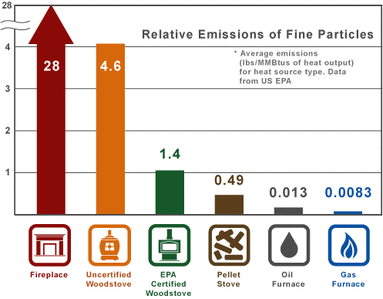|
Despite the fact that heating your house with wood does release CO2 into the atmosphere it does essentially amount to zero emissions when you take into account that there are new trees ready to absorb whatever CO2 is emitted from your chimney. So if you harvest the wood in an ecological responsible manner then then firewood can be a very eco friendly heating material of choice. There are 3 types of wood heaters that you can have in your home, the fireplace, wood stove and masonry heater/stove. These three technologies all have their strengths and weaknesses and it depends on what your are looking for in a heating system  Fireplaces Fireplaces are beautiful to look at and have been a staple of home heating for thousands of years. The main issue that occurs with fireplaces is that they can be horribly inefficient when compared to wood stove and masonry stoves. They will actually suck warm air from other rooms in the structure and make them cooler while only marginally heating the room they are in. If a fire place is still the choice for you then make sure to use seasoned wood that burns cleanly and hot enough to throw a lot of heat. You should also consider a fireplace design called a Rumford Fireplace. These shallow fireplaces with a angled back increases airflow through the fire and out the chimney. The design allows wood to burn much more cleanly and the angled back help reflect heat back out into the room better. Wood Stoves Some of the first true wood stoves came around in the 18th century and they were immediately noticed to be more energy efficient than traditional fireplaces of the day. There are many permutations of the wood stove but they all operate on the same basic principle. Today wood stoves are very well engineered and have very high combustion efficiency which helps reduce the amount of fine particles that they produce. The graph to the right shows the relative emissions of standard heating systems and as you can see the certified modern wood stove is vastly better than a fireplace. They do have some disadvantages when it comes to safety and aesthetics. The outside of the of the stove can become very hot and can easily hurt children or pets. Plus many of them are very utilitarian in design and do not mesh with modern concepts of beauty. Masonry Heater The advent of The Little Ice Age which precipitated a period of a severe and long winters was the primary driver behind the development of the masonry heater. The colder temperatures put pressure on the existing forests and current heating technologies of the day which demanded a better system. What came about was a type of stove with a new design that could reclaim 90% or better of the heat generated by the fire and slowly released the heat into the space over the rest of the day. This design also greatly increase increased burn efficiency of the wood which left very little residue and almost no chimney buildup. Another perk of this design was the amount of wood that is used. Most masonry heaters when used correctly will only have two quick very hot fires laid in twice a day for all day heating. When compared to wood stoves or fireplaces that have to be fed all day long to maintain heat. The major downside of a masonry stove is the size and the cost to have them built. It will cost into the thousands of dollars for even the smallest one but the money is well worth it for a good masonry stove.
0 Comments
Leave a Reply. |
AuthorHello my name is Josh Larson and I am the creator of the Green Living Library. Here on the blog you will find updates to content found in the Green Living Library as well as stories from those living the sustainable life already. Archives
December 2021
Categories
All
|